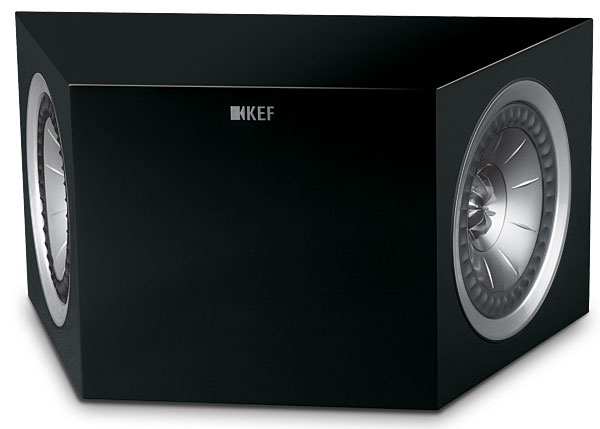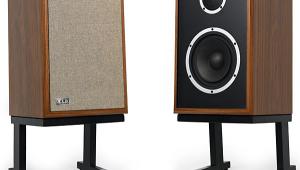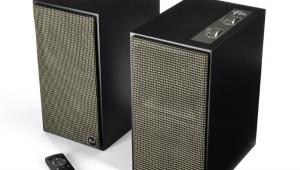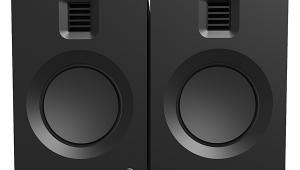KEF R300 Speaker System

Kent, in the south of England, was best known for hop farming when Raymond Cooke left Wharfedale and founded KEF in 1961. The company was named after the industrial site on which it was founded: Kent Engineering & Foundry. KEF’s numerous distinguished alumni include Laurie Fincham, who now develops next-generation audio technologies for THX, and Andrew Jones, who designs world-beating loudspeakers at a variety of price points for Pioneer and TAD. KEF has earned a reputation for making both great speaker systems and great speaker drivers, some of which were instrumental in the legendary BBC-designed LS3/5A, which KEF and other manufacturers have marketed in various forms. Roving through a New York cocktail party celebrating KEF’s 50th anniversary last year, hobnobbing with the audio elite, I found that the drive units inspired as much nostalgia as the speakers in which they were used. (To read about KEF’s history in more detail—and in a handsome coffee-table book, no less—see KEF: 50 Years of Innovation in Sound by Ken Kessler and Dr. Andrew Watson.)
Muon, Blade, and Beyond
KEF’s current product roster is worth a book in itself. If you’re looking for a speaker about as tall as you are, KEF offers two towers that would dominate a large space: the curvaceously sexy yet monumental Muon, and the more slender Blade. The latter, billed as the world’s first “single apparent source” speaker, has two sets of woofers set into the sides in opposing pairs plus a Uni-Q coaxial driver array in front. Uni-Q is the key to KEF’s kingdom, so we’ll return to that in a moment.
KEF’s Home Theatre lines include the KHT Series, with its oval-shaped satellite/subwoofer sets; the T Series, a flat-panel solution; and the Fivetwo, which claims full 5.1 surround using two speakers and a sub. KEF covers the custom-installation field with the in-wall CI Series and the all-weather Outdoor Series. There’s also a Universal Wireless System that offers quality sound transmission while operating in the 2.4-gigahertz band. But the heart of the KEF family is a comprehensive selection of what the company calls Hi-fi speakers that can be configured for surround or stereo listening. These six lines, spanning a wide range of prices, break down into those with curved enclosures and those with simpler rectangular builds. The curvy ones are the Reference Series, XQ Series, and Classic Q Series. The boxier and more affordable speakers are the Q Series, C Series, and the subject of this review, the newly introduced R Series.
The newly introduced R Series (which will replace the XQ in KEF’s lineup) is positioned as an affordable alternative to the pricier Reference Series, borrowing design features from both the Reference and the bleeding-edge Blade tower. Reviewed here are the R300 three-way monitor ($1,800 per pair), R600c center ($1,500), R800ds dipole surround ($1,800 per pair), and R400b subwoofer ($1,700 each), for a total system price of $6,800. Also available is the smaller, two-way R100 monitor ($1,200 per pair), whose 5.25-inch woofer would imply that it should mate well with the smaller R200c center ($1,000). And there are three tower models: the R900 ($2,500 each), R700 ($1,800 each), and R500 ($1,300 each), differentiated by their 8-, 6.5-, and 5.25-inch woofers.

While the R-Series enclosures may look like simple boxes, they are anything but simple on the inside. To minimize cabinet resonance, KEF uses what it calls “constrained layer damping,” with damping panels of different materials and thicknesses positioned in strategic places. This may be part of what gives the speakers the clean sound I’ll describe in more detail later. The designers also went out of their way to tame port turbulence using computational fluid dynamics. (KEF claims to be the first speaker maker to integrate computers into the design process back in the early 1970s.)
Like most of the R Series, the R300 monitor and R600c center have 1-inch tweeters and 5-inch midrange drivers built into KEF’s classic Uni-Q array. That means the tweeter is mounted coaxially (or concentrically, if that makes it easier for you to visualize) into the center of the midrange driver. That in turn effectively allows the two drivers to act as a single point source for the frequencies they cover: 500 hertz to 2.8 kilohertz for the midrange, 2.8 kHz and up for the tweeter.
Coaxial arrays bring the risk of a cupped-hands coloration as the tweeter’s output bounces off the midrange’s cone. But KEF’s long experience with Uni-Q, first introduced in 1988 and steadily refined ever since, has eliminated this potential side effect. “The key is getting the geometry of the tweeter dome and waveguide, formed by the cone, exactly correct,” KEF research engineer Jack Oclee-Brown explains. “Then the performance of a tweeter positioned in a waveguide can actually be better than one mounted directly on a baffle. This was something we first discovered when working on the Uni-Q for the Muon.”
Pull the magnetically attached grille off any R-Series baffle, and the speaker’s quiet appearance takes on shiny metal accents in the aluminum trim rings surrounding the drivers and within the drivers themselves. The rear-vented tweeter—optimized to move like a piston over its entire working range—is adorned with a tangerine waveguide that visually resembles the blades of a jet turbine more than the segments of a piece of citrus. It’s designed to control the tweeter’s response and dispersion to more closely match the output of the midrange driver, which is constructed with a die-cast aluminum basket. The aluminum-coned woofer is billed as “light, stiff, and strong.” In practice, I found it to be nimble, allowing bass frequencies above the sub crossover to manifest as tightly controlled pitches, free of the obvious bloat that sometimes plagues speakers great and small.
In the R300, the 6.5-inch woofer sits below the coaxial midrange/tweeter array, while in the R600c, two 6.5-inch woofers flank the coaxial array. The midrange cone is an alloy of magnesium and aluminum, while the woofer cone is an aluminum/paper hybrid and the tweeter dome is pure aluminum. All are said to be similar to the drivers in the big, bad Blade.






























































